 Petzlover
Petzlover Canis Panther is originated from United States but Brittany is originated from France. Canis Panther may grow 25 cm / 10 inches higher than Brittany. Canis Panther may weigh 45 kg / 100 pounds more than Brittany. Both Canis Panther and Brittany has almost same life span. Canis Panther may have less litter size than Brittany. Both Canis Panther and Brittany requires Low Maintenance.
Canis Panther is originated from United States but Brittany is originated from France. Canis Panther may grow 25 cm / 10 inches higher than Brittany. Canis Panther may weigh 45 kg / 100 pounds more than Brittany. Both Canis Panther and Brittany has almost same life span. Canis Panther may have less litter size than Brittany. Both Canis Panther and Brittany requires Low Maintenance.
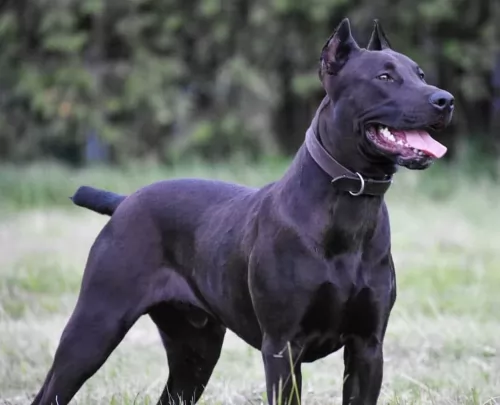 The Canis Panther is a strong, muscled dog who has been developed in the USA in the 1970s by Scorpio Jones, Michael Stratten, and Lucas Lopez. They mixed the Doberman Pinscher, the Great Dane the Labrador Retriever and the American Staffordshire Bull Terrier.
The Canis Panther is a strong, muscled dog who has been developed in the USA in the 1970s by Scorpio Jones, Michael Stratten, and Lucas Lopez. They mixed the Doberman Pinscher, the Great Dane the Labrador Retriever and the American Staffordshire Bull Terrier.
This dog hasn’t got a long history, having only been established in the 1970's, but the breeders wanted a dog much like the Doberman but somewhat larger and stronger. It is a dog breed which is still fairly unknown in the United States and elsewhere.
 One of the most intense bird dog breeds in existence is the Brittany, bred for hunt. The breed used to be called the Brittany Spaniel, but since the breed is closer to a setter or pointer, that moniker has been dropped. The Brittany is named for the French Province in which they were originally developed. Sometime from the 17th to the 19th centuries, the breed was developed. Images of a very similar dog can be found on 17th century paintings and tapestries. However, the first written description comes from 1850 by a Reverend Davies, describing a hunting episode. The breed was recognized officially in the early part of the 20th century and made a splash at the 1900 Paris Dog Show.
One of the most intense bird dog breeds in existence is the Brittany, bred for hunt. The breed used to be called the Brittany Spaniel, but since the breed is closer to a setter or pointer, that moniker has been dropped. The Brittany is named for the French Province in which they were originally developed. Sometime from the 17th to the 19th centuries, the breed was developed. Images of a very similar dog can be found on 17th century paintings and tapestries. However, the first written description comes from 1850 by a Reverend Davies, describing a hunting episode. The breed was recognized officially in the early part of the 20th century and made a splash at the 1900 Paris Dog Show.
The first official standards were written in about 1907 and the breed was recognized by the American Kennel Club (AKC) in 1934.The Brittany is expected to point to and then retrieve birds and other small ground game. Because the Brittany both points and retrieves they are known in the U.K. as a Hunt, Point and Retrieve breed or an HPR, and they have more Dual Champions than the rest of the AKC Sporting group.
There are actually two types of Brittanys in the minds of many breeders. There is the “French” Brittany and the “American” Brittany. When the breed arrived in the United States in 1931 they became immensely popular in a short period of time. In 1942 American Breeders began the American Brittany Club, rewriting the French standard to fit the dog they knew. Today there are definitely difference between the two sub-sets that can easily be seen. The French dog is smaller than the American dog. The American dog is a runner pacing ahead of the hunter while the French dog works more closely with their human companions. Another visible difference is that the French accept black spotted Brittanys, while in the United States a black spotted coat is considered a fault. Both sub-sets are known for their willingness to follow human directions, their eagerness for the hunt, and their agility and speed.
Unfortunately, the European wars took their toll on this breed as they did on many others. Following the second World War, their numbers in Europe were drastically reduced. The French had stop breeding them altogether during the war. It was in this depleted gene pool that the French agreed to accept the black spotted Brittany. Along with the U.S., Canada also does not recognize the black spotted Brittany.
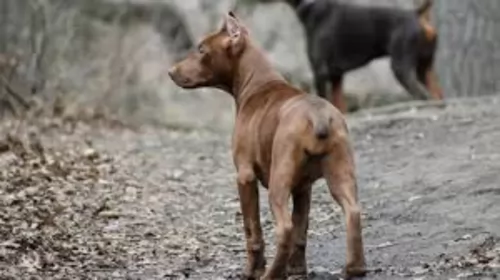 The Canis Panther is a large dog measuring roughly 68 – 77 cm in height and weighing around 50 to 63 kg. He has a deep chest and strong neck. The coat is short and dense and it is is essentially a solid color - fawn, grey, blue, chocolate or black.
The Canis Panther is a large dog measuring roughly 68 – 77 cm in height and weighing around 50 to 63 kg. He has a deep chest and strong neck. The coat is short and dense and it is is essentially a solid color - fawn, grey, blue, chocolate or black.
He looks magnificent with his cropped ears and short docked tail. Unfortunately with regulations surrounding the docking of dog’s tails, the dog these days is often left with a long tail.
He is an intelligent, territorial dog and makes an excellent watchdog. He is a dog which can be easily trained and socialized and then he makes a great family dog. He is loving and loyal to his human family, being somewhat aloof with strangers. His gets along well with children in the home as well as with other pets.
 The Brittany is much like other hunting dogs – pointers and retrievers – in size and stature. He is solid and strong but not heavy. He is compact with an average size head and floppy ears, docked tails or short natural tails, and expressively intelligent looking eyes. He is athletic, energetic, and alert. He has a long, elastic and free gait. The French dog is smaller and the dog with black spots is accepted. The American Brittany is larger and only a tri-color of orange, liver and white is acceptable.
The Brittany is much like other hunting dogs – pointers and retrievers – in size and stature. He is solid and strong but not heavy. He is compact with an average size head and floppy ears, docked tails or short natural tails, and expressively intelligent looking eyes. He is athletic, energetic, and alert. He has a long, elastic and free gait. The French dog is smaller and the dog with black spots is accepted. The American Brittany is larger and only a tri-color of orange, liver and white is acceptable.
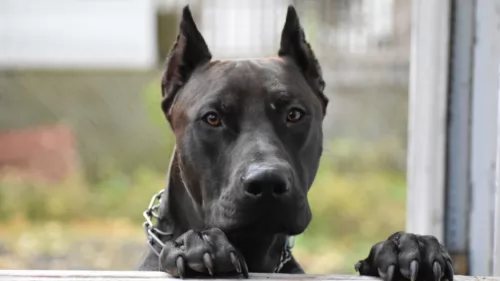 The Canis Panther is a loving dog in spite of his large, guard-dog looks. He is intelligent, bold and courageous, and when trained and socialized is a devoted, loyal, loving pet.
The Canis Panther is a loving dog in spite of his large, guard-dog looks. He is intelligent, bold and courageous, and when trained and socialized is a devoted, loyal, loving pet.
He is known for his high intelligence and becomes so attached to his human family he will fight to the death for them if needs be. He is a territorial dog and won’t welcome strangers to his door.
The Canis Panther puppy is outgoing and playful, loving the company of kids in the family.He requires a firm owner who can see to it that he gets in a good quota of exercise. He is an energetic dog and if he isn’t given enough exercise he can become destructive and aggressive through no fault of his own but because of an irresponsible owner.
The Canis Panther is a large dog but given love and proper care he becomes the most awesome, strong devoted pet and protector.
 The Brittany is particularly trainable and friendly. They love to play and are sweet-natured. They don’t due well with harsh correction though and a stern look will cause them to wither. Socialize them young or they can become shy around strangers. They are loyal and family oriented. They can easily become attached to their humans.
The Brittany is particularly trainable and friendly. They love to play and are sweet-natured. They don’t due well with harsh correction though and a stern look will cause them to wither. Socialize them young or they can become shy around strangers. They are loyal and family oriented. They can easily become attached to their humans.
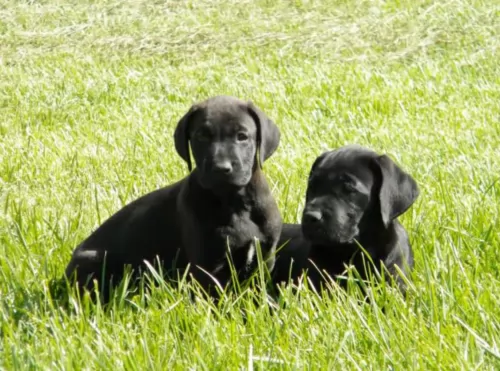 The Canis Panther breed is not known to have any particular illness and he can live to be 10, 11 or 12 years of age. However, like every other dog, there are some more common dog illnesses that you will need to be aware of and which are seen more commonly in larger dog breeds, some of which are -
The Canis Panther breed is not known to have any particular illness and he can live to be 10, 11 or 12 years of age. However, like every other dog, there are some more common dog illnesses that you will need to be aware of and which are seen more commonly in larger dog breeds, some of which are -
Larger breeds can be prone to bone cancer, known as Osteosarcoma and found more often in the limbs. Dogs develop swelling in the affected part of the limb and the bones can break easily. If you notice swelling or limping, see that you get your pet to the vet.
This is another kind of cancer which affects the Lymphocytes, a type of white blood cell. Dogs with Lymphoma may have an enlarged lymph node under the chin and neck for instance or the swelling could be in the groin area. Get your dog to the vet so as to have the lump biopsied.
 The breed is a hardy one and Brittanys are mostly healthy dogs. In Europe 1 in 5 dogs dies of old age and that age is usually 14 or 15 years. They do have a few issues that they may be susceptible to. These would include:
The breed is a hardy one and Brittanys are mostly healthy dogs. In Europe 1 in 5 dogs dies of old age and that age is usually 14 or 15 years. They do have a few issues that they may be susceptible to. These would include:
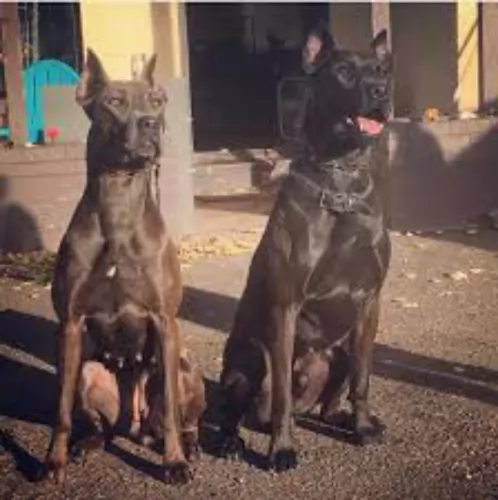 With his short coat, the Canis Panther is looked upon as a low mainenance dog. You’ll need to brush his hair at least twice a week though to remove loose hairs and keep the coat shiny.
With his short coat, the Canis Panther is looked upon as a low mainenance dog. You’ll need to brush his hair at least twice a week though to remove loose hairs and keep the coat shiny.
Brush your pet’s teeth at least 2 or 3 times a week. You get special toothpaste and toothbrush for dogs and your vet can guide you on how to use them. If you don’t attend to your pet's teeth, he can experience tartar build up. This can lead to gum disease and tooth loss. Not only that, bad teeth can affect other parts of the body too.
This breed comes from several large dog breeds and as a big dog, he is certainly going to need a good deal of exercise. He’ll need a walk every day or perhaps frisbee games in the park where he is made to run.
Any dog requires exercise, and especially a magnificent dog like this one. You want to make sure you maintain those lean, muscled limbs by ensuring he gets his fair share of exercise.
 Don’t overfeed your Brittany. Keep him at hunting weight by feeding a half a cup up to 2 cups per day depending on the size of your dog and activity levels. Serve this in two meals not one.
Don’t overfeed your Brittany. Keep him at hunting weight by feeding a half a cup up to 2 cups per day depending on the size of your dog and activity levels. Serve this in two meals not one.
Ears – prone to infections – make sure that you check them and wipe them out routinely to prevent infections.
Hip Dysplasia – bones don’t fit well into joints – this can be genetic or otherwise, causing lameness and arthritis. If severe it can require surgery to correct.
Epilepsy – mild or serious seizures are possible. This can be genetic/hereditary but is set off by an infectious disease of the brain, head injury, poison, tumor, or metabolic disorder. There is no cure, but medication can be very effective.
Hypothyroidism – Low levels of thyroid hormone – can cause drooping eyelids, obesity, lethargy, mental difficulties or irregular heat cycles or all of this. Medication is available as it is for humans but must be taken daily for the rest of the dog’s life
Canine Discoid Lupus Erythematosus – autoimmune disease that is rare in dogs. Cats and humans can also have it. It is a skin disease and does not become the more serious and deadly Systemic Lupus. The Discoid version of this disease causes loss of pigmentation and a scaling on the nose which can then progress to the skin around the ears, eyes and genitals. There could be ulcerated lesions and tissue death in more severe cases. Sun exposure can make the condition worse.
The Brittany is a hunting dog that acts like a pointer but will retrieve fowl and birds in the water or on land. If you don’t hunt, the Brittany can still be your family dog. They need lots of exercise and mental stimulation. They need a job if they are not going to hunt and expect them to be distracted by every bird they see. Try flyball, agility, FAST CAT, field trials and dock diving. They are very task oriented and have boundless energy. They excel at obedience and confirmation as well.